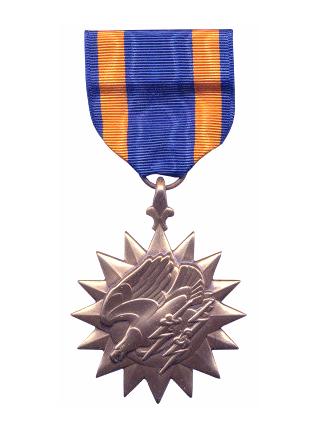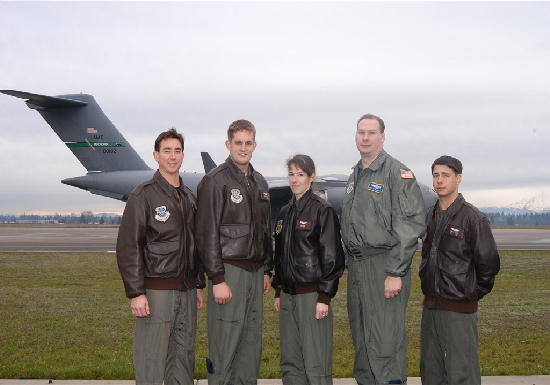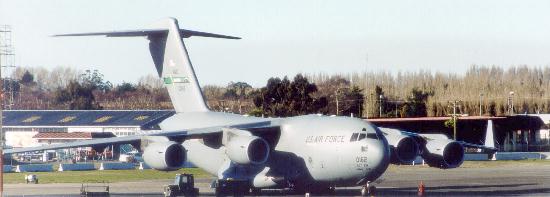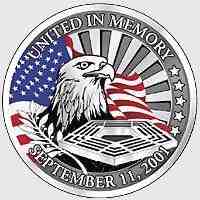_
|
OUR
HISTORY
|
| _ |
| C-17A
S/N 00-0182 |
| |
| Acceptance
date - February 14, 2002 |
| |
| McChord's
29th factory delivered C-17A |
| |
| |
 |
| U.S.
Air Force Air Metal |
| |
| |
 |
| |
On December
9 2003, a McChord crew flying C-17A 00182 managed to safely
land the aircraft after it was struck by an anti aircraft missile
shortly after takeoff from Baghdad IAP, Iraq. Pictured from
left: Capt. Paul Sonstein, 1st Lt. Andrew Oiland, Capt. Anne
Lueck, Technical Sgt. Jim Alexander and Staff Sgt. Eric Olsen.
|
| |
| |
| Decorated
McChord crew recounts enemy attack |
| By
Capt. Sam Highley 62nd Airlift Wing Public Affairs |
| |
MCCHORD AIR
FORCE BASE, Washington – Teamwork, training and the
durability of the C-17 Globemaster III are what got a McChord
aircraft safely on the ground after it was attacked by hostile
forces over Baghdad International Airport, according to the
aircrew.
The five crew members recently recounted what happened during
the 10 minutes from when their No. 2 engine exploded shortly
after take-off Dec. 9 to when they safely landed the C-17 back
at Baghdad IAP.
While an Air Mobility Command investigation team determined
that hostile action caused the catastrophic explosion and
continues to investigate to determine what exactly struck the
aircraft, the mission’s aircraft commander that day said he
knew right away they were hit by something.
“The impact just shuddered the plane,” said Capt. Paul
Sonstein, a pilot in AMC’s 62nd Airlift Wing here. “I
thought we were hit by something. I didn’t know what, but I
knew something got us.”
The crew immediately started their checklist, shutting down
the engine and planning their return to the airport. With
Captain Sonstein flying the plane, 1st Lt. Andrew Oiland, the
co-pilot that day and also a member of the 62nd AW, ran the
checklist and worked the radio. Behind him sat another 62nd AW
pilot, Capt. Anne Lueck, who watched over the cockpit to
ensure nothing was missed.
Tech. Sgt. Jim Alexander, a loadmaster with Air Force Reserve
Command’s 446th AW here, sat in the jumpseat behind the
aircraft commander and had the best view of the engine.
“We had a very large flame coming out of the top of the
engine,” Sergeant Alexander said. “It looked like a
flamethrower sticking out of the top.”
With Sergeant Alexander scanning the engine and monitoring the
fire, the C-17’s other on-board loadmaster and fellow 446th
AW reservist, Staff Sgt. Eric Olson, was downstairs taking
care of the passengers and coordinated everyone’s escape
once they landed.
Everyone doing their assigned job and working together as a
team helped get the aircraft safely on the ground, according
to Captain Lueck.
“The crew resource management training that we (all
received) proved to be invaluable,” she said. “I think
that’s what saved all of our lives and the lives of our
passengers – how well we coordinated (and) how well we
communicated with each other.”
The fact that many of the C-17’s systems are backed up
through redundancy also proved invaluable, as did the
aircrew’s simulator training, in which pilots regularly
practice landing with an engine out, Captain Sonstein said.
“It felt and handled no different than a four-engine
approach,” he said, referring to how the aircraft flew as he
circled back to the airport. “It was nothing different
because I was so used to the simulator.”
Captain Sonstein had to land the C-17 with only his standby
instruments. Despite being the first time to ever land the
aircraft without the benefit of the heads-up display, he did
so safely.
All five crew members’ performance that day earned them Air
Medals, which were presented by Vice President Dick Cheney
during a visit to McChord Dec. 22.
“It was an honor to be there and to shake his hand and get
(the Air Medal) pinned on by the vice president,” Captain
Sonstein said.
Despite the accolades, the crew knows there are still many
military people overseas fighting the war on terrorism in
similarly dangerous situations, Lieutenant Oiland said. “We
have people from all four services putting up with some pretty
tough conditions over there, doing some pretty amazing things
every day,” he said.
Still, Sergeant Alexander said he was incredibly impressed
with the response of his fellow aircrew members, who saved
their passengers’ lives, their cargo, a multi-million dollar
airplane and, not the least of which, their own lives.
“I’ve been flying for 14 years and I don’t think anybody
could have handled the situation any better than these guys
did,” Sergeant Alexander said. “They did a great job.”
(AFRC News Service from AMC News Service)
|
| |
| |
| |

|
| PHOTO
BY Ian
Hutchings |
| C-17A
-0182 on a stopover at Christchurch Airport, New Zealand, August
2003. |
| |
|
| Website
provided and maintained by: |
| |
| The
McChord Air Museum Foundation |
| P.O.
Box 4205 |
| McChord
AFB, WA. 98438-0205 |
| 253-982-2485 |
| e-mail
- mamfound@mcchordairmuseum.org |
| |
 |
| |
|

|
| _ |
| |
|